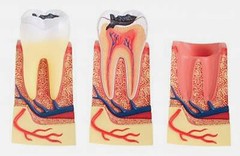 The teeth are composed of four different types of tissues, some of which are located more on the surface of the teeth, and some of which are located deeper near the root. In order for dentists to understand what type of dental procedure they need to perform on a patient, they must first understand which area of the tooth is being affected. One of the areas of the tooth that can result in root scaling and other such dental procedures is the cementum.
The teeth are composed of four different types of tissues, some of which are located more on the surface of the teeth, and some of which are located deeper near the root. In order for dentists to understand what type of dental procedure they need to perform on a patient, they must first understand which area of the tooth is being affected. One of the areas of the tooth that can result in root scaling and other such dental procedures is the cementum.
What Is Cementum?
The
Effects of Cementum Buildup
When buildup occurs on the cementum part of the tooth, it can lead to various adverse side effects. Perhaps the most common cause of cementum buildup is when large amounts of plaque accumulate on the cementum. Leaving this plaque and other debris on the cementum area of the tooth can eventually lead to periodontal disease if the condition is left untreated. Fortunately, there are modern procedures that can assist patients with removing any buildup on the cementum areas of their teeth.
Removing Cementum Buildup
 The primary dental procedure used to remove buildup from the cementum is known as a debridement. Basically, a debridement procedure consists of combining the processes of root scaling and root planning to go beneath the gum line and remove any trapped plaque and other debris from around the cementum area of the tooth. This type of procedure is usually suggested if a dentist determines that a patient has an early active stage of periodontis. It is supposed to serve as a preventative measure to help prevent periodontal disease from worsening.
The primary dental procedure used to remove buildup from the cementum is known as a debridement. Basically, a debridement procedure consists of combining the processes of root scaling and root planning to go beneath the gum line and remove any trapped plaque and other debris from around the cementum area of the tooth. This type of procedure is usually suggested if a dentist determines that a patient has an early active stage of periodontis. It is supposed to serve as a preventative measure to help prevent periodontal disease from worsening.
The procedure is performed by numbing the areas where the dentist is going to conducting the debridement, and then an antiseptic is applied to the area to help loosen up the plaque and other debris to be removed from the affected areas. Afterwards, the dentist utilizes a sharp tool known as a curette to scrape off the hardened plaque and tartar from the area. He or she will usually do this by scaling along the affected area in an upward motion. Sometimes dentists might also employ the assistance of an ultrasonic scaling device that helps break up the particles beneath the gum line that the curette couldn’t reach. Of course, after all this is done, then the dentists will plane or smooth out the root surfaces covering the cementum in an attempt to make the cementum smooth once again and better equipped to fend off additional plaque and tartar buildup in the future.
References:
PatientConnect. “Periodontal Scaling and Root Planing – Dental Procedure Code Description.” Retrieved on January 28, 2016, from https://www.patientconnect365.com/dentalhealthtopics/article/periodontal_scaling_and_root_planing__dental_procedure_code_description.
RDHMag. “Debridement = scaling and root-planing plus.” Retrieved on January 28, 2016, from http://www.rdhmag.com/articles/print/volume-19/issue-5/columns/periodontics/debridement-scaling-and-root-planing-plus.html.
PatientConnect
6729 Lake Rd
Windsor WI 53598
608-846-5407
http://www.patientconnect365.com
RDHMag
1421 S Sheridan Rd
Tulsa, Oklahoma 74112
800-331-4633
http://www.rdhmag.com
Images:
https://farm8.staticflickr.com/7349/12984746885_9be7bef00e_m.jpg
https://farm8.staticflickr.com/7667/17108601880_d40f52613a_m.jpg